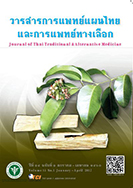Botanical Identification of Chan-thet and Chan-hom Crude Drugs by Thin Layer Chromatography
Main Article Content
Abstract
"Chan-thet" and "chan-hom" are crude drugs whose identifications are confusing; so their botanical
species should be investigated. Fifteen samples of crude drugs çchan-theté and 11 samples of "chanhom"
were randomly purchased from traditional drugstores throughout Thailand. Their chemical
fingerprints were investigated using the thin layer chromatography method. The results were compared
with authentic samples, and a-santalol purified in our laboratory was used as the chemical marker. The
results indicated that all samples of "chan-thet" and 9 samples of "chan-hom" possessed a-santalol as
their chemical constituent. Among them, 11, 3 and 1 samples of "chan-thet" gave chemical fingerprints
similar to Santalum spicatum, S. album and S. lanceolatum, respectively; whereas 8 and 1 samples of
"chan-hom" were similar to those of S. spicatum and S. lanceolatum, respectively. Two other samples of
"chan-hom" revealed chemical fingerprints similar to Mansonia gagei. Based on the results, it is concluded
that "chan-thet" and "chan-hom" currently available in traditional drugstores originate from
four different plant species, mostly from the wood of S. spicatum. And the results can be applied for the
quality control of "chan-thet" and "chan-hom" crude drugs.
Article Details
References
2. National Drug System Development Committee. National list of essential medicines, 2012. Nonthaburi: Thai
Agricultural Cooperative Community Press; 2012. 108 p. (in Thai)
3. Thamawech W. Textbook of Ratanakosinûs medicine. Bangkok: Silpa Siam Packaging and Publishing; 2004. 720 p. (in Thai)
4. Forest Herbarium of Forest and Plant Conservation Research Office, Department of National Park, Wildlife and Plant Conservation, Ministry of Natural Resources and Environment. Thai plant names Tem Smitinand, revised edition 2014. Bangkok: National Office of Buddhism Press; 2014. 812 p. (in Thai)
5. Picheansoonthon C, Chavalit M, Jeerawong W. The explanation of royal medicine from Narayana textbook (king Bhumibol Adulyadejûs gloden jnbilee 72 years of reign
edition). Bangkok: Amarin and Wisdom Foundation; 2001. 777 p. (in Thai)
6. Department for Development of Thai Traditional and Alternative Medicine, Department of Medical Sciences, and Food and Drug Administration, Ministry of Public
Health. Monograph of selected Thai material medica, volume 1. Bangkok: Amarin Printing and Publishing; 2009. 326 p. (in Thai)
7. Pongboonrod S. Exotic plants in Thailand: medicinal use of foreign and Thai traditional medicines. Bangkok: Krungthon press; 1979. 600 p. (in Thai)
8. Soonthornchareonnon N, Ruangwises N. Quality of Thai crude drug: research to sustainable development. Bangkok:National Research Council of Thailand; 2008. 588 p. (in Thai)
9. Department of Medical Sciences, Ministry of Public Health. Thai Herbal Pharmacopoeia, Volume IV, 2014. Bangkok:Office of National Buddishm Press; 2014. 197 p.
10. Chailorm C, editor. Code of Thai medicinal formulae. Nonthaburi: Sopon Publishing; 2011. 374 p. (in Thai)
11. Eastern Botanical Garden (Khao-hin-son), Center for Education of Khao-hin-son under the Royal Development Project. Herb in forestry herbal plantation of Khao-hinson. Chachoengsao: Jetanaromphan Partnership Limited; 2007. 301 p. (in Thai)
12. Eiadthong W. Letûs know about Mai-Chan and custom of royal familyûs funeral. J Forest Manag. 2008;2(4):29-45. (in Thai)
13. Srisopon S, Burana-osot J, Sotanaphun U. Botanical identification of Chan-khao and Chan-thana by Thin-Layer Chromatography. Thai Pharm Health Sci. 2015;10(1):19-24. (in Thai)
14. Srisopon S, Burana-osot J, Sotanaphun U. Identification of Chan-chamot by Thin Layer Chromatography. Thai Bull Pharm Sci. 2016;11(1):47-57. (in Thai)
15. Soonthornchareonnon N, Sotanaphun U, Wongsinkongman P, editor. TLC: A simple method for qualitative analysis of Thai crude drugs. Bangkok: Faculty of Pharmacy, Mahidol University; 2008. 448 p. (in Thai)
16. Phattanawasin P. Thin layer chromatography. Pathum Thani: Thammasart University Press; 2007. 143 p. (in Thai)
17. Tistaert C, Dejaegher B, Heyden YV. Chromatographic separation techniques and data handling methods for herbal fingerprints: A review. Anal Chim Acta. 2011;690:148-61.
18. Sotanaphun S, Phattanawasin P, Burana-osot J, Srisopon S, Ashok PK, Huang B. Botanical identification of Kotchula-lampha in current use by Thin-layer Chromatography. Thai Pharm Health Sci. 2013;8(1):1-6. (in Thai)
19. Okugawa H, Ueda R, Matsumoto K, Kawanishi K, Kato A. Effect of α-santalol and β-santalol from sandalwood on the central nervous system in mice. Phytomedicine.
1995;2(2):119-26.
20. Boldovini N, Delasalle C, Joulain D. Phytochemistry of the heartwood from fragrant Santalum species: a review. Flavour Fragr J. 2011;26:7-26.
21. El-Halawany AM, El Dine RS, Hattori M. Anti-estrogenic activity of mansonone G and mansorin A derivatives. Pharm Biol. 2013;51(8):948-54.
22. Subasinghe SMCUP. Sandalwood research: a global perspective. J Tropical Forestry and Environment. 2013; 3(1):1-8.
23. Arun Kumar AN, Joshi G, Mohan R. Sandalwood: history, uses, present status and the future. Current Science. 2012;103(12):1408-16.
24. Valder C, Neugebauer M. Western Australian sandalwood oil-new constituents of Santalum spicatum (R. Br.) A. DC. (Santalaceae). J Essent Oil Res. 2003;15:178-86.
25. Brand JE, Fox JED, Pronk G, Cornwell C. Comparison of oil concentration and oil quality from Santalum spicatum and S. album plantations, 8-25 years old, with those from mature S. spicatum natural stands. Aust For. 2007; 70(4):235-41.


